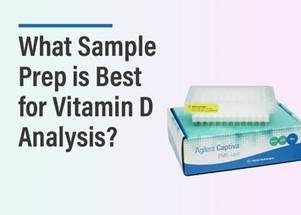Posted by Chrom Tech on 14th Oct 2025
What Sample Prep is Best for Vitamin D Analysis?
With growing demand for sensitive and specific analytical techniques, laboratories are increasingly focusing on accurate low-level detection of endogenous vitamins and hormones in biological samples. One of the most notable examples is vitamin D analysis. Maintaining proper vitamin D levels is vital: deficiency can lead to low bone density, while excessive amounts may cause harmful calcium accumulation. However, accurate quantification of 25-hydroxyvitamin D₂ and D₃ metabolites can be challenging, particularly because lipids in biological matrices often interfere with LC/MS detection.
Selecting the Right Sample Preparation Method
Traditional methods such as protein precipitation do not effectively remove lipids, which can cause ion suppression and reduce method sensitivity. While solid phase extraction (SPE) can eliminate lipids, it requires complex method development and multiple steps that slow down high-throughput workflows.
A more efficient and reliable alternative is Agilent’s Captiva EMR-Lipid — a rugged sample preparation solution designed for selective lipid and matrix removal without sacrificing analyte recovery. Available in a 96-well plate format, Captiva EMR-Lipid is ideal for high-throughput clinical and research laboratories. For fully automated workflows, pair it with a Chrom Tech collection plate to streamline sample handling.
Captiva EMR-Lipid leverages a dual-mechanism design — combining size exclusion and hydrophobic interaction — to efficiently remove phospholipids and other matrix components. This dramatically reduces ion suppression and enhances LC/MS reliability for 25-hydroxyvitamin D₂ and D₃ analysis, producing consistent, reproducible results.

The 96-well plate and 1 mL cartridge formats include a solvent retention frit that enables in-well protein precipitation to further simplify sample preparation. The frit design supports smooth flow under vacuum or positive pressure — though positive pressure manifolds are generally recommended for optimal control and consistency. Learn more on our Positive Pressure Processor product page.

LC/MS/MS Analysis of 25-Hydroxyvitamin D Metabolites
Liquid chromatography coupled with tandem mass spectrometry (LC/MS/MS) is now the preferred method for precise quantification of vitamin D metabolites. Agilent’s Poroshell 120 EC-C18 columns deliver exceptional efficiency and reproducibility for this application. For best performance, we recommend using the Poroshell 120 EC-C18 analytical column with the corresponding guard column to ensure longevity and consistent peak shape.

For a detailed look at method conditions and results, review Agilent’s full application note. The Captiva EMR-Lipid workflow demonstrated exceptional phospholipid removal and signal stability for vitamin D metabolite analysis — simplifying sample preparation without compromising data quality.
Frequently Asked Questions About Captiva EMR-Lipid Sample Prep
How does Captiva EMR-Lipid improve vitamin D analysis?
By selectively removing phospholipids and other matrix components, Captiva EMR-Lipid minimizes ion suppression, enhances analyte recovery, and ensures more accurate quantitation of 25-hydroxyvitamin D₂ and D₃ metabolites.
Is Captiva EMR-Lipid compatible with automation?
Yes. Captiva EMR-Lipid is available in a 96-well plate format, ideal for automated and high-throughput LC/MS/MS workflows. Pairing it with Chrom Tech’s polypropylene collection plates enables seamless automation.
What type of pressure system should I use with Captiva EMR-Lipid?
A positive pressure manifold is preferred for precise, uniform sample flow through each well. Chrom Tech offers a Positive Pressure Processor designed specifically for controlled sample processing.
Which column should I use for vitamin D LC/MS/MS analysis?
We recommend the Agilent Poroshell 120 EC-C18 column and matching guard column for high-resolution separation and reliable quantification of vitamin D metabolites.


